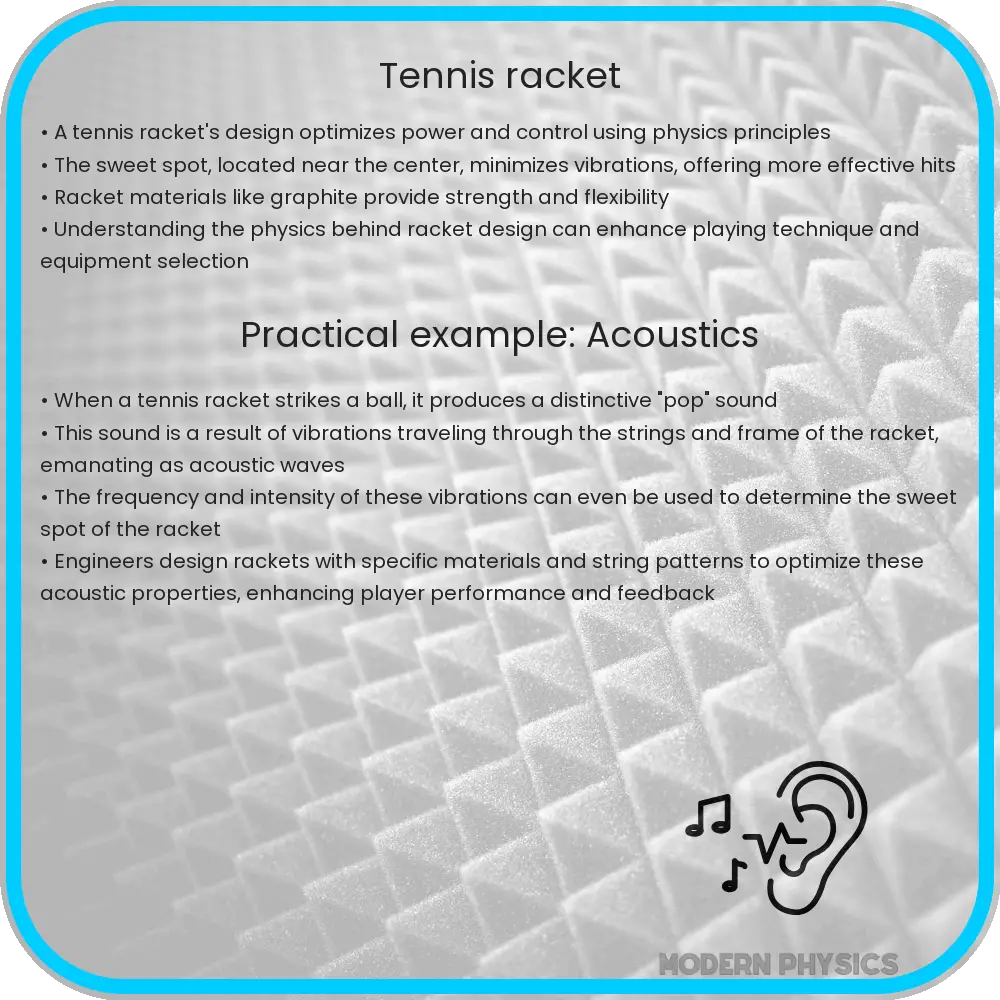Explore the science behind tennis racket dynamics in this detailed guide covering power, spin, control, and the latest advancements in racket technology.

Tennis Racket Dynamics: Power, Spin & Control
The physics of tennis rackets is a fascinating subject that combines principles of aerodynamics, material science, and biomechanics. Understanding how rackets contribute to power, spin, and control can significantly enhance both player performance and equipment selection.
Power
Power in a tennis racket is primarily influenced by its mass, balance, and the stiffness of its frame. A heavier racket with more mass concentrated towards the head (head-heavy balance) can generate more power. This is due to the principle of angular momentum, where the mass further from the pivot point (in this case, the player’s hand) generates greater force on impact. The stiffness of the racket frame also plays a crucial role. Stiffer rackets bend less upon impact, transferring more energy to the ball, thus providing greater power. However, this comes at the cost of reduced shock absorption, potentially leading to arm discomfort.
Spin
Spin is a critical aspect of modern tennis, offering players control over the ball’s trajectory and bounce. The racket’s string pattern (dense or open) significantly affects spin potential. Open string patterns (fewer strings) allow for more string movement and a greater ‘bite’ on the ball, enhancing topspin and slice. Additionally, advancements in string materials, such as polyester, have enabled players to generate more spin due to their increased ability to snap back into place after deforming upon ball contact.
Control
Control in tennis rackets is a function of racket head size, string tension, and frame flexibility. Smaller heads provide more precision but less power, favoring skilled players who can generate power themselves. String tension also affects control; higher tension provides more precision, while lower tension enhances power and spin. Frame flexibility is a double-edged sword; more flexible frames provide better feel and control but can reduce power and stability.
These factors are interdependent, and the ideal balance varies based on player skill, style, and physical attributes. The latest racket technologies often focus on optimizing the interplay between power, spin, and control to suit different types of players.
In the next part, we will delve deeper into the materials and technologies used in modern tennis rackets, and how they contribute to these three critical aspects of the game.
Advancements in Tennis Racket Technology
The evolution of tennis racket technology has been a game-changer in the world of tennis. Manufacturers continually experiment with new materials, designs, and string technologies to optimize power, spin, and control.
Materials and Construction
Modern rackets are primarily made from graphite, a lightweight yet sturdy material that allows for power and control. Some rackets also incorporate materials like titanium, kevlar, or carbon fiber to enhance specific characteristics. For example, carbon fiber can increase frame stiffness for more power, while kevlar can improve vibration dampening for better control.
String Technologies
The choice of strings and stringing patterns has a profound effect on racket performance. Polyester strings, popular among professional players, offer durability and allow for extreme topspin. Meanwhile, natural gut strings provide superior tension retention and a softer feel, benefiting control and touch. Hybrid stringing, combining two different types of strings, has become popular for balancing power, spin, and feel.
Racket Shape and Size
Racket head size also impacts performance. Oversized heads offer a larger sweet spot, making them more forgiving and powerful, ideal for beginners and intermediate players. Advanced players often prefer midsize rackets for greater control and precision. The beam width of the racket also influences its characteristics; thinner beams are generally more flexible, offering better feel and control, while thicker beams are stiffer, providing more power.
Customization and Player Specifics
Customization of rackets to fit individual needs is increasingly common. Players adjust grip size, weight distribution, and string tension to find the perfect balance that complements their playing style. This personalization ensures that the racket acts as an extension of the player, allowing for optimal performance.
Conclusion
The dynamics of a tennis racket – encompassing power, spin, and control – are crucial in shaping a player’s game. Advancements in materials and technology have allowed for a wide range of rackets catering to different playing styles and abilities. Whether it’s the frame’s stiffness, the string’s material, or the racket’s overall balance, each aspect plays a pivotal role in the on-court performance. For players, understanding these dynamics is key to selecting the right equipment and maximizing their potential on the court. As tennis continues to evolve, so too will the technology behind the rackets, further enhancing this fascinating interplay between player and equipment.
